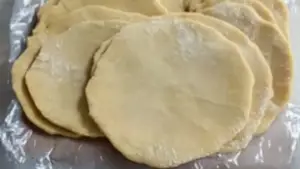
When it comes to comfort food, empanadas have carved out a special place in the hearts (and stomachs) of food lovers around the globe. From street vendors in Buenos Aires to family kitchens in Puerto Rico, the allure of a golden, crispy, flavor-packed pastry never fails. But what really makes an empanada unforgettable? While fillings are important, it’s the authentic empanada pastry dough that forms the heart and soul of this cherished treat. In this post, we’ll take a deep dive into mastering empanada dough from scratch—so you can bring a little taste of tradition to your own kitchen.
Understanding What Makes Empanada Dough So Special
At first glance, you might think empanada dough is just like any other pie crust. But there’s a world of difference, and understanding those nuances is key to creating a truly authentic empanada pastry dough. Unlike traditional pie crusts, which are made to be extra flaky and delicate, empanada dough is designed to be more pliable and slightly chewy so it can hold all kinds of savory or sweet fillings without breaking or leaking.
Each region adds its unique twist. In Argentina, the dough is soft and buttery. In Colombia and Venezuela, corn flour might be used instead of wheat flour. Over in Spain, you’ll find the dough sometimes includes olive oil and white wine. No matter the origin, the goal is the same: a dough that’s tender enough to bite through easily, but strong enough to keep all that juicy goodness safely inside.
The Building Blocks: Key Ingredients for Traditional Empanada Dough
Let’s break down the essential ingredients that make up an authentic empanada pastry dough. Every component plays a role in taste, texture, and structure.
-
All-Purpose Flour – This is the backbone of the dough, offering structure and elasticity. Use unbleached for a more rustic, traditional flavor.
-
Salt – Enhances flavor and balances the fat.
-
Fat (Butter or Lard) – This is where much of the magic happens. Butter gives a rich flavor, while lard is traditional in many regions for its flakiness and earthy taste.
-
Egg – Not always included, but often used to enrich the dough and add pliability.
-
Liquid (Water or Milk) – Used to bind the dough. Milk creates a slightly richer texture, while water keeps it classic.
-
Optional: White Vinegar or Lemon Juice – Just a splash helps tenderize the dough and prevents too much gluten development.
Pro tip: Want that iconic golden hue? Add a pinch of paprika or annatto to your flour mix!
How to Make Empanada Dough Step-by-Step (The Traditional Way)
Ready to get your hands dirty (and buttery)? Making authentic empanada pastry dough isn’t difficult, but a little technique goes a long way. Here’s how it’s done:
1. Mix the dry ingredients. In a large bowl, combine 3 cups of flour with 1 teaspoon of salt. If you’re adding any dry seasoning or spices like paprika, toss it in now.
2. Cut in the fat. Add ½ cup of cold butter or lard, cut into cubes. Using your fingers or a pastry cutter, work the fat into the flour until it resembles coarse crumbs. Some larger pea-sized bits are okay—that’s what gives texture.
3. Add wet ingredients. Beat 1 egg and mix with 1/3 cup of cold water (or milk). Slowly pour the mixture into the dry ingredients, stirring gently until a shaggy dough forms.
4. Knead briefly. Turn the dough onto a floured surface and knead it just enough to bring everything together—about 1 to 2 minutes. Avoid overworking the dough.
5. Let it rest. Wrap the dough in plastic wrap and let it rest in the fridge for 30 to 60 minutes. This step is crucial! It allows the gluten to relax and makes rolling much easier.
Use gentle, patient movements at every stage. Dough responds best to kindness!
Rolling and Shaping: The Art of the Empanada Disc
Once your dough has rested, it’s time to turn it into the perfect little envelopes for your fillings.
-
Divide the dough into small balls, about golf-ball sized.
-
Roll each ball into a thin circle, roughly 4 to 6 inches in diameter.
-
Use a cookie cutter, plate, or glass to cut uniform discs.
-
Lightly dust each disc with flour to prevent sticking.
Keep your workspace floured and your rolling pin moving in all directions to maintain a round shape. If the edges crack, press gently to bring them back together.
Dough Storage: Make-Ahead and Freeze Like a Pro
Empanada dough is one of those things that actually gets better with a little planning.
-
Refrigeration: Wrapped tightly in plastic wrap, your dough will last up to 2 days in the fridge.
-
Freezing: Roll out and cut your dough into discs, layer them with parchment paper, and freeze them in a ziplock bag. They’ll keep for up to 3 months.
-
To use: Let frozen discs thaw overnight in the fridge or for a couple of hours at room temperature before filling.
Planning ahead means empanadas are never more than a few steps away!
From Dough to Delicious: Assembling and Cooking Empanadas

Now that you’ve nailed the dough, let’s elevate your empanada game even further. Choosing the right filling and cooking method makes all the difference.
Filling Combos to Die For
Here are a few popular and authentic empanada filling options that complement the traditional dough beautifully:
-
Beef Picadillo (Argentina): Ground beef, green olives, hard-boiled eggs, onion, and spices.
-
Chicken Sofrito (Puerto Rico): Shredded chicken with sofrito sauce, olives, and bell peppers.
-
Cheese & Onion (Chile): Melty cheese with caramelized onions and oregano.
-
Sweet Plantain & Black Bean (Vegan): Creamy and satisfying with a kick of chili.
Keep your filling cool before placing it on the dough—hot fillings can make the dough soggy.
Sealing Like a Pro: Keep It All Inside
Sealing is where the artistry comes in—and also where many beginners go wrong. Here’s how to do it right:
-
Place about 1 to 2 tablespoons of filling in the center of the disc.
-
Fold the disc in half over the filling to form a half-moon.
-
Press the edges together firmly.
-
Use a fork to crimp the edges or try the traditional repulgue—a twisted rope-style fold used in Argentina.
Always make sure there are no gaps. A little egg wash around the edges can act as glue.
Bake or Fry? Let’s Settle This.
There’s no one right way to cook an empanada. Here’s a comparison so you can choose what works best for your craving.
Baking:
-
Preheat oven to 375°F (190°C).
-
Brush with egg wash for a golden crust.
-
Bake for 25–30 minutes until puffed and browned.
-
Healthier and easier to do in batches.
Frying:
-
Heat neutral oil to 350°F (175°C).
-
Fry empanadas 2–3 at a time for 2–4 minutes per side.
-
Drain on paper towels before serving.
-
Crispier and more indulgent.
If you’re feeling fancy, try baking half the batch and frying the other half—see which one you love more!
Serving Empanadas: The Finishing Touches
Presentation is everything, even with casual eats like empanadas. Here are some pairing ideas that take them to the next level:
-
Dips and Sauces:
-
Chimichurri (herby and garlicky)
-
Garlic aioli
-
Spicy tomato salsa
-
-
Sides:
-
Simple mixed greens
-
Black bean salad
-
Pickled vegetables
-
Empanadas are also perfect party food, picnic snacks, or even a dinner main—just add a salad and call it a meal!
Common Empanada Dough Problems—and How to Fix Them
Even seasoned home cooks run into trouble. Don’t worry—these fixes will get you back on track:
-
Dough too dry: Add a teaspoon of water at a time until it comes together.
-
Dough too sticky: Dust with flour and knead gently until manageable.
-
Dough cracks when rolling: Let it rest longer or bring it to room temperature.
-
Empanadas burst open: Avoid overfilling, and seal the edges tightly.
Remember, the more you make them, the better you’ll get. Dough making is part science, part intuition.
Final Thoughts: You’re Now an Empanada Dough Master!
You did it. You’ve taken the journey through every step of authentic empanada pastry dough—from flour to finish. With this guide in hand, you’re equipped to honor tradition, get creative in the kitchen, and (most importantly) enjoy every delicious bite.
Empanadas aren’t just food. They’re connection. To culture, to family, and to the joy of making something with your hands. Whether you’re filling them with spicy beef or sweet guava and cheese, the foundation remains the same—a well-made dough that holds everything together.
Now go roll, fill, bake, or fry—and don’t forget to share with people you love.
Frequently Asked Questions
What is the difference between empanada dough and pie crust?
Empanada dough is more elastic and less flaky than pie crust. It’s made to be handled, shaped, and stuffed, whereas pie crust is meant to be tender and crumbly.
Can I make empanada dough ahead of time?
Absolutely! Make it up to two days in advance or freeze for up to three months. Just be sure to bring it to room temperature before rolling.
Is it better to bake or fry empanadas?
That depends! Baking is healthier and easier for large batches. Frying gives you a rich, crispy finish. Both are delicious.
Why is my empanada dough cracking?
It might be too cold or too dry. Let it rest and warm slightly, and knead in a little water if needed.
Can I use whole wheat flour?
You can, but expect a denser result. Try mixing it 50/50 with all-purpose flour for a healthier option without sacrificing texture.
